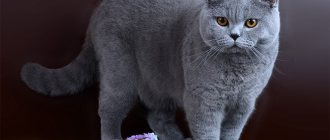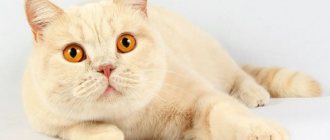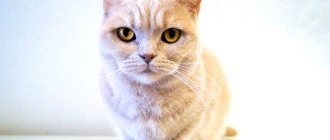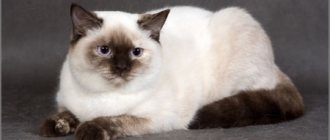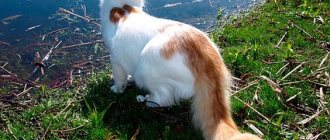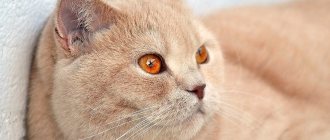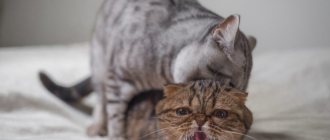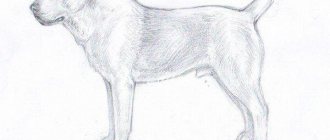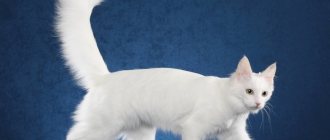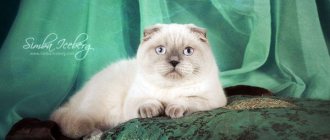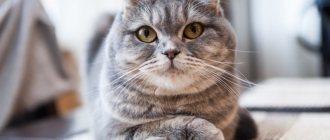Havana brown
This is a relatively young breed that appeared in Europe in the 19th century. Great Britain is considered its homeland. Local breeders decided to breed an animal whose body would be covered with chocolate-colored fur. To do this, they crossed representatives of several different breeds, including Russian Blue, brown Siamese and domestic black cats. In the 50s of the 20th century, these animals were brought to America. A few years later they were officially recognized as an independent breed.
Havana Browns are charming brown cats with a playful disposition and a gentle voice. Their weight ranges from 4-6.5 kilograms. The elongated head has raised whisker pads, bright green eyes and forward-leaning ears. The animal has a strong, muscular body with soft, shiny fur, the color of which varies from red-brown to warm chocolate.
Description and color standard
In the mechanics of hair coloring for chocolate British cats, it is important to understand two components: pigmentation and genetics.
A pair of pigments is responsible for the variety of colors in cats - eumelanin (black) and pheomelanin (red). At the moment of conception, the “chocolate” genetic instruction is transmitted from the parents, along with the chromosome set, to the kitten. The location of the capsules with the dye and their density in each hair depends on it.
Solid colors involve even coloring of the hair along its entire length - from the root bulb to its tip. Under the influence of the genetic code, a pigment of the desired color is produced in the cat’s body and enters the fur.
Other features depend on the combination of genes.
- Gene B is responsible for black color. In its dominant form, it gives a rich, deep charcoal shade.
- The next variety is bb. This is the chocolate color of cats.
- The final form of b1b1 is cinnamon, cinnamon, a clarified version of chocolate.
- In the dominant form, D does not allow the fur to take on shades other than the specified color.
- The dd combination reduces the color intensity and lightens it by several tones.
Genes that are responsible for the presence of patterns on the surface of the coat also take part in the formation of color. For example, the agouti gene (A) “allows” or “prohibits” the appearance of a pattern.
All striped and spotted patterns on the fur of a British cat appear only thanks to this component. To produce solid colors, a recessive aa (not agouti) is required.
Next comes the D gene (densepigmentation), which is responsible for color intensity:
The British chocolate-colored cat carries the genetic formula aabbD-, which determines all the parameters of the color of its coat - not agouti (aa), chocolate (bb), without bleaching (D). Exactly the same meanings are inherent in chocolate-colored Scottish Fold cats. The rules of genetics apply to everyone without exception.
British chocolate cats are also characterized by the following characteristics:
- copper, honey or amber eyes;
- brown nose;
- paw pads are brown or lightened cinnamon (cinnamon).
This is interesting! The chestnut-brown coat color is prohibited for other native breeds. It indicates crossbreeding with younger or unstable cat species.
Persian cat
These magnificent animals have a very long history. Their development began around the 16th century. The first representatives of this breed came to Italy from one of the Persian provinces. Subsequently, they gained extraordinary popularity among European breeders and quickly spread throughout the continent.
These animals have a memorable appearance. The average weight of Persians reaches 6-8 kilograms, but larger individuals are also found in nature. On a rounded head with thick cheeks, strong jaws, a powerful chin and a convex forehead, there are small ears, expressive shiny eyes and a short, upturned nose. The large body with a wide back and massive chest is covered with thick long hair. As for color, the standard allows several options. But black, white, red, blue, cream and brown cats are especially popular.
History of the breed
The York Chocolate cat, unlike most breeds, was not bred by breeders. She was born in the early 80s into an ordinary American family. A long-haired cat gave birth to kittens from an unknown father, one of them was a rich chocolate color. The owner decided to start breeding this unusual species and, as a result of several closely related crosses, she succeeded. The first representatives of the variety were the cat Ted and the brown cat Coconut, and the breed received its York name in honor of the city of New York, which was located near these events.
Domestic Yorkie Chocolate Cat
Initially, the breed was not recognized by felinological organizations, until 1995 it was in the status of “for amateur breeding” and all representatives (about 27 kittens) lived in their own Chifari nursery. But this year she wins the champion title in ACFA, receives recognition, and in 2009 the WCF standard and the TICA breed standard are approved. After this, nurseries in Canada, Europe and America began breeding the breed.
Shorthair exotics
These unpretentious beautiful animals are close relatives of the Persians. They were bred in the 1960s through the efforts of American breeders.
Shorthaired exotics are large cats with a strong, muscular body of a square format, under which there are short, thick limbs. The round head with convex cheeks and a massive lower jaw has widely spaced eyes, small ears and a miniature upturned nose. The entire body of representatives of this breed is covered with thick, silky short fur with dense undercoat. As for the color, it can be anything. But the most common ones are red, blue, white, cream and brown-white cats.
Shorthaired exotics have a calm, friendly disposition. They do not tolerate loneliness well, but they will never bother you with tenderness. Thanks to their natural balance and serenity, these non-aggressive animals easily adapt to any conditions.
The character of a chocolate Briton
Chocolate Britons have an aristocratic disposition. They love freedom and have self-esteem. There is a certain detachment in the character of animals. A Briton can become an affectionate pet if you raise him from the first days of his life. Well-mannered cats and cats are calm and friendly. They are affectionate towards familiar people and love to play with children.
At the same time, British cats remain unobtrusive and can spend time alone. Owners can leave representatives of the breed at home when they go on vacation. A temporary move to another home will be more stressful for the animal than living alone.
But if the owners are not at home for several months, the cat will become weaned from the owners and may not recognize them when they meet. When leaving your pet at home during the holidays, make sure that someone visits him once every 1-2 days.
Representatives of the British breed are curious. They want to know everything that is happening in the house. Owners should hide valuables to protect them from the teeth and claws of a pet. Over time, adults become phlegmatic and lose interest in research.
In British cats, hyperactivity is often combined with awkwardness. Stocky and massive animals are not distinguished by grace. Little kittens walk awkwardly and fall often . When exploring the surrounding space, your pet may get injured.
Before adopting a kitten, carefully inspect the house and remove objects that are dangerous for it.
Scottish cats
These animals appeared as a result of a natural genetic mutation. It occurred more than half a century ago in an ordinary white cat named Susie. Subsequently, offspring were obtained from her. One cat from this litter ended up in the family of shepherd William Ross. It was she who became the ancestor of the new breed.
Scottish cats are animals with a strong body, a wide chest and a strong neck. On a round head with a well-developed chin and pronounced whisker pads, there are large eyes and a neat nose. The ears of representatives of this breed can be either straight or downward. The entire body of these animals is covered with a beautiful thick six. As for color, many options are allowed here. Despite this diversity, black, blue and brown Scottish cats are the most common.
Representatives of this breed are distinguished by their unobtrusive, affectionate character. They are extremely clean and can live even in a small apartment. At a young age, these animals are very active and playful. But over time they become more phlegmatic.
Caring for a cat and the main mistakes of owners
The British are very demanding about the quantity and quality of food. Premium or super-premium food is suitable for them. The calorie content of the daily diet should correspond to the age and weight of the animal. Tables for calculating the daily value are on cat food packages. British breed cats can be picky and refuse food they don't like.
Do not overfeed the animal or leave it without food for a long time. Adult animals are prone to overeating and obesity. Breeders advise feeding the British 1-2 times a day and leaving a bowl of clean water freely available. If the animal has special features (allergies, diabetes, etc.), the diet should be prepared together with a veterinarian.
The owner of a British dog must take care of maintaining the hygiene of the pet:
- Bathe the animal once every 6-8 months using cat shampoo.
- Comb once a week with a metal comb.
- Clean your pet's eyes, nose, and ears once a week.
- Brush your pet's teeth and gums once a week with a special brush and paste.
- Carefully trim claws as necessary (declawing is prohibited; it harms the psychological health of the animal).
It is also necessary to take care of the pet's health. All vaccinations for cats must be done according to the calendar, which can be obtained at any veterinary clinic. When walking outdoors or in contact with other animals, you need to use products against fleas and other parasites.
The chocolate color of British cats fades if the animal is not properly cared for. If a cat is sick, stressed or not eating properly, the fur becomes less thick and shiny. If there is a sudden change in color or thickness of fur in an adult animal, you should show it to a veterinarian.
Free range is not recommended for the British . When a cat is exposed to sunlight for a long time, the chocolate color fades unevenly. This will be grounds for disqualification from the exhibition. A free-range pet can become infected with parasites or get injured.
British cats
These animals are distinguished by their strong build with a wide chest and short legs. The round head with well-defined cheekbones has erect ears and large eyes. The entire body of the British is covered with beautiful short fur with a thick undercoat. Representatives of this breed often include tortoiseshell, red, lilac, cream, black and dark brown cats.
The British are very affectionate and clean animals that quickly get used to their owner. At the same time, they calmly tolerate short separation from the owner. These calm, balanced cats do not require complex care. They are not picky when it comes to food, and happily eat both industrial and natural food.
Yorkie chocolate cat
This is a very young breed, which for a long time remained unrecognized by professional felinologists. It was registered only in 1983 and quickly gained enormous popularity. Today, European, American and Canadian breeders are engaged in its breeding.
These animals have a long, muscular body with a thin neck and slender limbs. On a round head with a wedge-shaped muzzle, there are not too large oval eyes and large ears. The entire body of representatives of this breed is covered with soft, silky fur with a glossy sheen. As for color, only lilac and brown cats are allowed by the standard.
These graceful animals have a cheerful, active disposition. They quickly become attached to their owners and are quite trainable. These curious cats need constant human interaction. They are extremely careful and completely devoid of aggression.
BRITISH CHOCOLATE KITTENS: PHOTOS OF SMALL KITTENS
The gallery contains photos of British chocolate-colored kittens.
| In our cattery you can “buy a real British kitten.” We have many different colors, we will help you choose and answer all your questions! |
Burmese cat
Representatives of this breed have a very long history. The first mentions of them are found in eastern chronicles dating back to the 15th century. Supposedly, they lived in temples and were considered talismans for the rich of Bangkok. They came to Europe in 1930 thanks to Dr. Joseph Thompson. It was he who was sent such an unusual gift from Southeast Asia.
Today there are two varieties of Burmese cats - European and American. They differ from each other in the structure of the skeleton and the shade of the coat. The European Burmese has a graceful body with a thin, long neck and a rounded, wedge-shaped head. Representatives of the American branch are distinguished by a strong physique with well-developed muscles and a wide muzzle. Regardless of the type, the entire body of these animals is covered with short, shiny, silky hair. As for color, the standard allows lilac, blue and brown cats, photos of which can be seen in today’s publication.
Both American and European Burmese are distinguished by their friendly and accommodating character. They quickly get used to their owners and do not tolerate loneliness well. They are cheerful and playful, like little kittens. But if necessary, they are able to show sensitivity and delicacy.
How to choose a kitten
Burmese kittens are born small in appearance and parameters and look small at 3 months. At first, the babies are all white and the main color will develop when they are one year old.
When choosing, they evaluate the appearance of the kitten; it should not be thin, but active. Examine the eyes, ears, anus. A healthy baby does not have gray-yellow discharge, and the stomach is not swollen and soft.
If possible, examine the cat's mother and the family's habitat.
Before selling kittens, breeders vaccinate kittens according to age, wean them from mother's milk and transfer them to independent feeding.
In the nursery, a complete package of documents with a veterinary passport and a registered pedigree will be prepared for a Burmese kitten. When studying the composition of ancestors, they make sure that there are no hereditary diseases in the line.
Important! It is recommended to buy an elite breed of Burmese kitten from licensed nurseries, which guarantee that the baby will not have hereditary diseases.
Burmese kittens photos
How much does a Burmese kitten cost?
The cost of the Burmese breed depends on the nursery and its pedigree.
- Pet class kittens. Those with deviations from the standard and castrated cost up to 15 tr.
- A breed class pet with a good pedigree for subsequent breeding of offspring costs more, ranging from 15 to 35 thousand rubles.
- Elite show class kittens, future winners of exhibition shows, cost over 35 thousand rubles.
Nurseries
There are not very many nurseries in Russia and neighboring countries. The popularity of the Burmese cat breed in the country is still gaining momentum.
- Moscow, Russia. Cattery "Burma Aldis", Burmese cats.
- Contacts; https://www.burma-aldis.ru/.
- Russia, Moscow. Cattery "O'KLER" Burmese cats.
- Contacts: +7 964 519-0517 [email protected] ://www.okler.ru/
- Saint-Petersburg, Russia. Cattery "Bourimea*RU" Burmese cats. System: FIFe
- Contacts: +7-921-421-79-09; e-mail; https://www.bourimea.ru/
- City: Riga (Latvia). Cattery "LV*Malsan" Burmese cats. System: FIFe.
- Contacts: +371 29127603; e-mail; www.malsan.lv
Chantilly-Tiffany
This is a relatively rare breed that received official recognition in 1979. Chantilly Tiffanys are slender, graceful cats with a wedge-shaped head, bright eyes and wide-set round ears. The entire body of these animals is covered with elegant, silky fur, completely devoid of undercoat. As for color, previously these were exclusively brown cats. But the modern standard allows for the presence of lilac, blue or spotted-striped skins.
These playful and friendly animals quickly become attached to their owners. At the same time, they do not require constant attention and complex specific care. Chantilly Tiffanys often purr in a quiet, gentle voice, reminiscent of a dove's coo.
Fur of four-legged friends
The main color of animals is chocolate color. It has a deep and rich shade. According to the standard, there should be no tabby marks, spots or light-colored hairs at all. The chocolate pigment should be distributed evenly throughout the coat. In this case, the hairs should be soft and short.
Kittens take a long time to acquire a truly chocolate shade. In some cases, the formation process can continue for 15 months. Sometimes the fur can acquire a brown tint, as shown in the photo. However, over time, kittens lose it.
British cats can have fur of different shades of chocolate. Therefore, it will be possible to find pets whose fur coat may be the color of a bitter or milky dessert. A kitten of this color is very popular today. In this, it is not inferior to its purple and blue counterparts.
Devon Rex
These long-eared cats are more reminiscent of fairy-tale elves. Their story begins in the middle of the 20th century. It was then that people living near one of the English mines accidentally found an unusual cat with curly fur, which became the ancestor of a new breed.
These are large, muscular animals with a broad chest, thin legs and a long tail. On the large head of the Devon Rex there are huge ears that look like locators, and expressive elongated eyes. The entire body of representatives of this breed is covered with soft, dense hair with wavy curls. The most common cats are white, honey, black, lilac and brown.
They all have an active, energetic character. They love outdoor games and love to jump on high cabinets.
